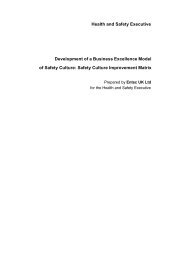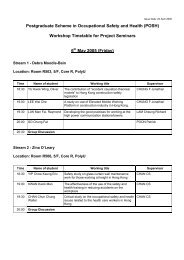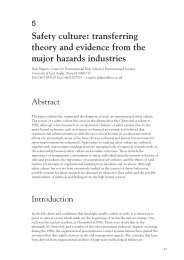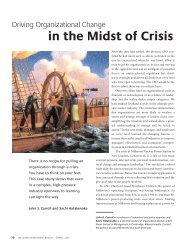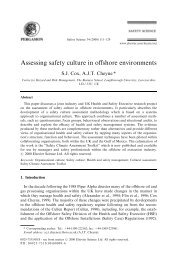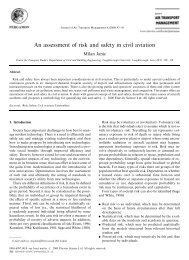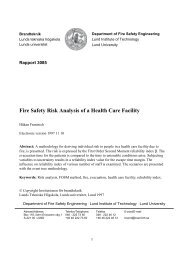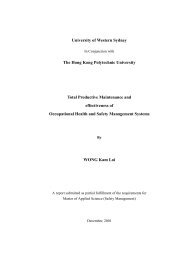The relationship between employees' perceptions of safety and ...
The relationship between employees' perceptions of safety and ...
The relationship between employees' perceptions of safety and ...
You also want an ePaper? Increase the reach of your titles
YUMPU automatically turns print PDFs into web optimized ePapers that Google loves.
M. O’Toole / Journal <strong>of</strong> Safety Research 33 (2002) 231–243 239<br />
Sample question related to Factor 3: Are employees checked on a routine basis to see<br />
whether they are doing their job safely?<br />
Factor 4 represents Employee Involvement <strong>and</strong> Commitment. <strong>The</strong> commitment aspect<br />
is expressed in questions about whether ‘‘coworkers support the <strong>safety</strong> program,’’ <strong>and</strong><br />
whether ‘‘employees caution other employees about unsafe practices.’’<br />
Sample question related to Factor 4: Do your coworkers support the company’s <strong>safety</strong><br />
program?<br />
Factor 5 deals with Drugs <strong>and</strong> Alcohol, <strong>and</strong> how effectively the company is able to deal<br />
with these potential problems. A ‘‘no’’ answer to these series <strong>of</strong> questions is actually the<br />
‘‘positive’’ response.<br />
Sample question for Factor 5: Are employees who are using drugs or alcohol on the job<br />
able to work undetected?<br />
Factor 6 addresses Emergency Response. Plants with a high degree <strong>of</strong> agreement by<br />
employees have been found to have lower accident rates.<br />
Sample question for Factor 6: Have you been properly trained to respond to an<br />
emergency situation in your work area?<br />
Factor 7 measures Off-the-Job Safety. <strong>The</strong>se questions have been validated such that<br />
facilities with better employee evaluations <strong>of</strong> <strong>of</strong>f-the-job <strong>safety</strong> efforts have lower accident<br />
rates. Secondarily, this factor measures the effort that management has put into generalizing<br />
<strong>safety</strong> in the employees’ lives.<br />
Sample question for Factor 7: Is <strong>of</strong>f-the-job <strong>safety</strong> a part <strong>of</strong> your company’s <strong>safety</strong><br />
program?<br />
<strong>The</strong>se factors are helpful as diagnostic tools for setting priorities for improvement. One<br />
way to accomplish this is to take the scores for each factor <strong>and</strong> compare them to the<br />
existing norms. Table 3 provides insight into fundamental areas <strong>of</strong> strength <strong>and</strong> weakness<br />
in the subject company’s management <strong>of</strong> <strong>safety</strong>.<br />
<strong>The</strong> results presented by factor in Table 4 show the percent positive responses for each<br />
factor aggregated for all the subject company’s employees who completed <strong>and</strong> returned the<br />
survey. <strong>The</strong> table also gives the difference <strong>between</strong> the subject company’s responses <strong>and</strong><br />
the normative data from previously administered surveys. A ‘‘plus’’ difference <strong>between</strong> the<br />
subject company’s data <strong>and</strong> the norm indicates that the subject company’s results are better




